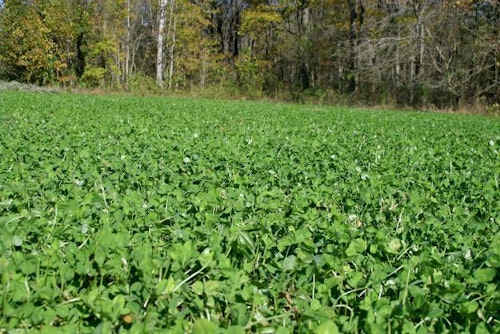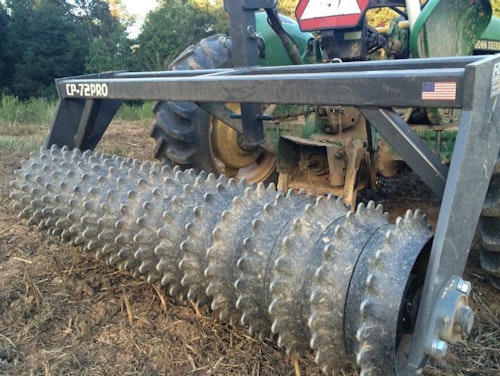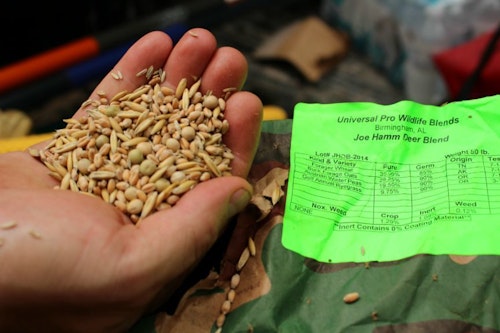
Simple hand-held spreaders are inexpensive, and many hunters will go this route rather than investing in big equipment. Be sure to stock some spreaders that can get customers into the food plot game for a low cost.
I was on my fourth hour of planting food plots for a second day in a row when two migrant workers from the farm where we hunt came to bring me some more diesel fuel. As I approached on the tractor, I noticed them grinning and looking at each other quizzically.
“What’s the matter?” I asked, worried that one of my tires was flat, my face was smeared with dirt or my jeans might be unzipped.
“Oh, nothing,” one answered. “We just can’t believe anyone would do that much work just to feed deer.”
I started to explain that I wasn’t working that hard just to feed deer, but to kill them. But his point had already been made. I realized that even though it seems crazy to many nonhunters, some hunters (like me) are willing to put in a lot of time, effort and money to plant food plots in preparation for the fall hunting seasons.
Since that’s the case, retailers who are prepared to supply those hardcore hunters with the food plot products they need can bolster their bottom line in the process.
Creating a good food plot is a multi-step process. First, hunters must locate a spot on their hunting property that is the appropriate size and in a desirable location to provide deer with a food attractant. To prepare the area, hunters must first mow, spray, or mow and spray the area to clear it of its current vegetation. Next, the ground must be broken up to allow for good seed-to-soil contact. At this time, a soil sample should be taken so any necessary fertilizers can be added. Next, seed must be selected from a large variety of plants and blends, then spread in the correct manner and amount. Finally, with all that done, it’s time to pray for rain.
To cater to hunters wanting to gear up to plant their first food plot, there are several product categories retailers should consider.

Sprayers
Killing off existing vegetation can help alleviate a lot of future problems with a new food plot. Sprayers are available in all shapes, sizes and configurations, and that’s a good thing. Some hunters making very small plots can use a handheld or backpack sprayer. These are handy and can get the job done if the food plot area isn’t too large.
Those with bigger plots need sprayers that pull behind or mount to ATVs, allowing them to spray the plot faster and more easily. Hunters who plant plots that cover several acres will need a sprayer made for pulling behind a farm tractor.
Sprayer buyers also need some kind of herbicide to use with their sprayer, so stocking a few kinds could lead to an additional sale. Glyphosate (Roundup) is the most common herbicide used, but other popular ones include Sethoxydim (Poast Plus, Vantage and G-Pro) and Clethodim (Arrest Max, Arrow and Select).
Mowers
The main job of a good, heavy-duty mower is to clear a food plot area when preparing to establish a new plot. But they are also useful for cutting paths and helping control weeds in perennial food plots.
Some hunters load up their zero-turn mower or lawn tractor from home and use them for this purpose. However, most food plots are much rougher than lawns, so it’s easy to tear up a lawnmower using it in this manner. Other hunters use one of the mowing implements made for pulling behind ATVs. A good example is one of the pull-behind mowers made by Kruz Engineering. Those with very large plots typically use a power takeoff-driven brush hog pulled behind a farm tractor. These can mow a lot of area very quickly, but purchasing and maintaining a tractor solely for food plot purposes is a very expensive proposition.
Discs
Discs and other implements (plows, cultivators) made for breaking up the ground are necessary, even for those who choose to make a food plot without first spraying and/or mowing. That’s why these implements should be at the top of the list for retailers choosing to carry food plot products.
Except for those made to pull behind tractors for farming, most discs are designed for pulling behind ATVs to break up the ground before planting. In this case, there’s a trade-off between weight and how deep discs are able to break the ground, since most ATVs won’t pull an overly heavy implement. Models that have pin adjustments for the angle of the disk blades and electric motors to raise and lower the disk gangs within the implement’s frame are more expensive, but many find them worth the extra money.
Disc/harrows, which combine two functions in one implement, are also available and are very versatile.

Harrows
This implement is made to smooth food plots once they’ve been broken up with a disc or plow. Most are made for pulling behind ATVs, and some are adjustable for multiple levels of aggressiveness in smoothing the ground. For example, in some models the harrow’s teeth can be aimed down and forward for an aggressive cut, down and to the rear (less aggressive) or up for simple smoothing.
Many hunters trying to make a food plot on a budget try to make a DIY harrow from an old piece of chain link fence or even skip this part of the process altogether. But most eventually end up purchasing a harrow made for the purpose, since results are better.
In recent years, many hunters have begun using cultipackers instead of harrows for smoothing broken ground. A cultipacker is a heavy, iron roller, usually with iron cleats, that is rolled over soil after it has been turned to firm and smooth the seedbed. Cultipackers are generally much more expensive than harrows, though.
Seeders/Fertilizer Spreaders
Seeders and fertilizer spreaders also come in a wide range of sizes, and choosing the right one depends mostly on the size of the food plot.
For seeders, handheld and over-the-shoulder units are perfect for small jobs that can be done on foot. Of course, those planting bigger plots and large fields are going to a need a seeder/spreader that pulls behind an ATV or tractor. ATV-mounted spreaders also come in a wide range of sizes and price ranges.
Most spreaders are easy to adjust and can do double duty for both seeding and fertilizing.
Seed/Seed Blends
Don’t forget the seed to be planted in food plots. While implements are typically a one-time sale, seed and seed blends are needed every year to replant food plots.
The type of seed hunters choose for their plots varies by many factors, including region of the country, soil type and what other hunters have convinced them they need to try.
According to the Quality Deer Management Association (QDMA), food plot plantings fall into two categories: warm-season and cool-season. Warm-season plantings are typically planted in spring and grow throughout the summer and into fall. They include forages like soybeans, corn, sorghum and cowpeas.
Cool-season forages are planted in the fall or early spring, and some grow throughout the year. They include forage plants like wheat, rye, oats, clovers and brassicas. Warm-season forages are typically annuals, while cool-season forages can be annuals or perennials.
Carrying a good selection of seed and seed blends will give customers lots of options, depending on what kind of food plot they have in mind.
4 Seed Blends to Consider Stocking
For retailers just entering the food plot business, consider these four blends for starters.
Cool-Season Blends
- Whitetail Institute Imperial Whitetail Clover Seed provides antler-building protein and is tolerant to cold weather.
- Antler King Honey Hole Food Plot Mix is a blend of brassicas, rape seed and turnips.
Warm-Season Blends
- Pennington Fall Forage Food Plot Seed combines winter legumes, brassica and fall grains.
- Evolved Harvest Mean Bean Crush is a mix of bean and pea seeds.

A Tree Deer Will Love
If your food plot customers are looking to branch out into longer-term projects like establishing an orchard, they’ll be searching for the right tree. While it’s probably not practical to stock trees yourself, you can help steer them in the right direction — good advice is always appreciated
Historically, the American chestnut tree was a favorite of deer and other wildlife, until a blight virtually eliminated them from the landscape. But a preference for chestnuts is still encoded into the deer DNA. They recognize the nutritional superiority of chestnuts, which contain four times the carbohydrates of a white oak acorn, 2.5 times the protein and only a fraction of the fat. Chestnut trees offer additional advantages to land managers as well. They grow faster and bigger, sometimes bearing in two to five years, where a white oak might not bear for 20 years.
Through some fortunate discoveries and serious grafting and cross-pollination work with a blight-resistant American chestnut and a Chinese chestnut, Dr. Robert Dunstun created the Dunstan chestnut, a breed with the optimal combination of blight resistance and production of large, high quality nuts. Today, Dunstan Chestnuts and a variety of other mast producing trees and shrubs are grown at Chestnut Hill Orchards in Alachua, Florida. The family business, which began as a commercial chestnut orchard, now produces stock specifically designed and cultured for wildlife mast orchards.
5 Great Food Plot Implements
No idea where to start? These five food plot implements will help you reach customers in the segment immediately.
- The NorthStar ATV Boomless Broadcast and Spot Sprayer is narrow enough to go anywhere an ATV will go but still sprays a wide swath.
- Plotmaster’s Plotmower Rough Cut Mowers pull easily behind an ATV to cut down current vegetation in proposed food plot areas.
- The King Kutter 48-inch Flip-Over Disc is designed for breaking ground with minimal effort.
- The Field Tuff Heavy Duty Drag Harrow is pulled behind an ATV to smooth the soil after turning.
- Moultrie’s ATV Spreader hooks to an ATV and can be used for spreading both seed and fertilizer.
Wrapping Up
As deer hunting popularity remains high, the interest in food plots will likely continue to grow. Likewise, so will the need for accessories, implements and seed blends for creating, planting and maintaining food plots.
Overlooking the potential food plot customer is a poor decision for retailers who target hunters. With the right knowledge of what is needed to successfully grow quality food plots, jumping into the market isn’t that big of leap.





